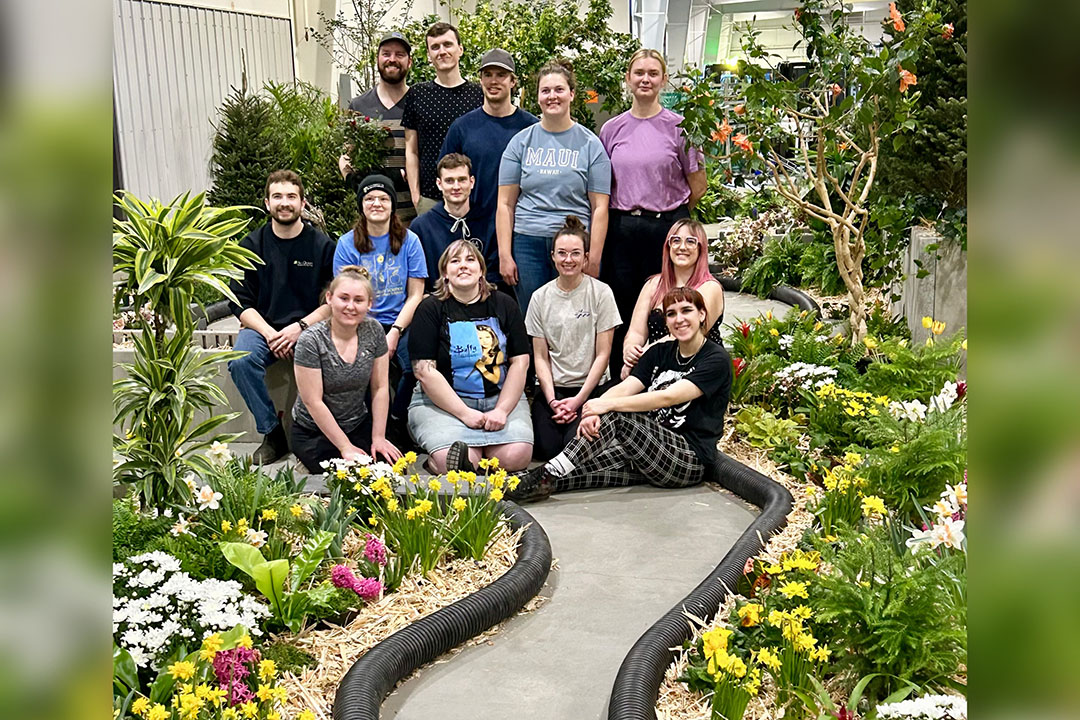
Experiential learning blooms in USask landscape design course
The Campus to Creation student garden made its inaugural debut at Gardenscape 2025.
By Brett Makulowich“Experiential learning enhances not only students’ comprehension but also their self-confidence,” said Jessa Hughes, a horticulture lecturer in the College of Agriculture and Bioresources (AgBio) at the University of Saskatchewan (USask). “Students are more engaged and excited to learn when they can apply concepts in practical ways. Creating a beautiful design is one thing but bringing it to life is a far more enriching experience.”
Hughes is the instructor for the PLSC 435.3 Landscape Design course. The project-based course examines the intersection of art and science in landscape design, with a strong focus on experiential learning.
“While fourth-year horticulture students are well-versed in scientific aspects, many are encountering art and design for the first time in this course,” said Hughes.
The final project for the course was a large indoor landscape design at Gardenscape 2025. Gardenscape is an annual horticulture, gardening and outdoor living tradeshow held in Saskatoon. Thirteen Horticulture Science students participated, with each student being assigned part of the landscape to design.
“By working together to design the landscape and create a cohesive flow, our class was able to think outside the box and bring a beautiful vision to life,” said Brooke Bedard, a Horticulture Science student. “Gardening provides a hands-on way to learn about science, from plant structures and soil composition to the role of ecosystems.”
“What surprised me most about this project was how much the final design changed from the original plan,” said Bedard. “Some constraints along the way meant we had to adjust, especially when ordering plants, since some plants were out of stock and substitutions were necessary. Seeing the final result come together was a rewarding experience that highlighted the value of teamwork and creative problem solving.”
This experience mirrors what often happens in real life, according to Hughes.
“This is a common experience in landscape design, as thing rarely go perfectly to plan,” said Hughes. “This experience highlighted the importance of adaptability and problem-solving in real-world scenarios.”
The idea for AgBio students to participate in Gardenscape originally came from Jackie Bantle and Gloria Gingera in the Department of Plant Sciences in AgBio. Bantle, greenhouse and horticulture facility manager, and Gingera, a communications assistant, are members of the Gardenscape Board. Hughes developed the concept of the student project with Bantle and Gingera.
Funding for students to purchase plants was provided by AgBio and the Department of Plant Sciences. Once Gardenscape was over, some plants were auctioned off through Prairieland Park (where Gardenscape is held) and via a plant sale held in the Agriculture Atrium on campus. The funds raised go on to support the student landscape design project in future years.
“Providing students with a platform such as Gardenscape to showcase their work is a way to communicate the excitement for the future of the horticulture industry to the broader public,” said Hughes.
“The field of horticulture is incredibly diverse, and this diversity translates into a wide range of career opportunities,” said Hughes. “The Horticulture Science major at USask is designed to support this diversity and provide flexibility within the degree, allowing students to tailor their studies to their interests.”
Two years into a different degree program at USask, Bedard transferred into AgBio and the Horticulture Science major.
“I was looking for a career that was more immersive and connected to the environment, allowing me to work closely with nature while making a positive impact,” said Bedard. “My love for plants, sustainability, and helping others made the transition easy. Horticulture has shown me how much you can love what you’re doing, all while making it a career.”
“We have a vibrant and growing horticulture sector here in Saskatchewan, much of which is due to the support of our local communities,” said Hughes. “I firmly believe that the horticulture industry is poised for significant growth, driven by renewed interest in domestic food production and sustainable food systems.”
Watch a virtual walk-through of the Campus to Creation student garden.

